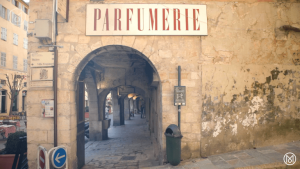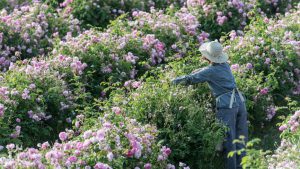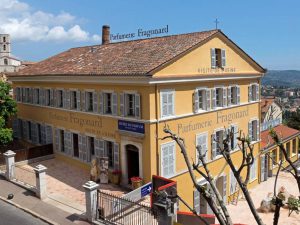Wander Grasse with us, the town that inspired some of the world’s most legendary scent-makers—and the school responsible for its next generation.

Just north of Cannes, and to the west of Nice on the Côte d’Azur of France, is Grasse, without question the historic world capital of perfumery. Buildings hug the landscape in this hillside town, and the surrounding basin has the loamy soil and gentile climate perfect for the growth of sweet-scented flowers. Even in winter, when I visited, there were tufts of mimosa everywhere, powdery billows of yellow honeyed fragrance and pollen into the air.
The ghosts of perfume’s past, scents created in Grasse by brands like Dior and Chanel, also float invisibly. The science of perfumery is a venerable tradition here, dating back centuries; nearly everything in town still bears the word parfum, and almost everyone who was or is involved in fine perfumery has worked here, or at least visited. A now-defunct hotel sits empty at the top of the hill right at the entrance to town with giant letters that read “Hotel des Parfums” announcing the town’s reputation like a Hollywood billboard.
In the 1740s, Grasse was mainly a leather hub, exporting fine gloves to Genoa and London via the nearby port of Cannes. The town so reeked of leather-making and tanning chemicals that a glover named Jean de Galimard was compelled to scent his products with a tincture of rose water and spices, legendarily offering a pair to Catherine de Medici, who became obsessed. Soon les parfums de Grasse were all the rage. Jean later supplied the court of King Louis with olive oil, pomades, and perfumes from which he developed his first formulas. Today, a modern iteration of the Parfumerie Galimard continues to produce both signature scents and new works, often in collaborations with celebrated perfumers like Caroline de Boutiny and Jacques Morel.  (They also operate a factory and museum.).
(They also operate a factory and museum.).
At one point in the 19th century, all the major perfumeries were found in Grasse, from Bruno Court to Chiris and Molinard (only the latter remains). Most of the world’s production of essential oil extraction was centered here, specifically florals like orange blossom, jasmine, tuberose, and rose. And every May, the town dresses its streets with roses for ExpoRose.
“We would come for summer holidays by car from Marseille to Grasse [in the 1960s],” says Philippe Massé, president of Prodarom, theNational Union of Aromatic Products Manufacturers, and a resident of Grasse for a half-century. I am meeting with him at his office just outside town. “There were no big expressways, so the little streets would cross the flower fields of jasmine. It smelled like rose, jasmine, and mimosa everywhere. It was absolutely a dream.”
No longer the hamlet it once was in the mid-18th century, Grasse today is a small city of about 50,000, and almost a tenth of the population works in the perfuming industry. At least 70 factories remain in the Pays de Grasse area, including Robertet, which has created fine raw materials since 1850, and a new LVMH laboratory dedicated to haute parfumerie, Les Fontaines Perfumées, housed in a villa just above the former Hotel des Parfums.
“Most of the world’s best-known companies are established in Grasse,” says Massé. “They are not present in the same size and activities as 1950, but they are present. The quality of the flowers, especially the rosa centifolia, and the jasminum grandiflorum and the tuberose produced in the area of Grasse, are very special. The odor of these flowers is incredible.”
The old town that once housed the most important perfume factories is mostly rundown these days but, despite this, it’s still thoroughly charming. I spend time eating delicate orange blossom fougassette [sweet flatbread] from Bakery Venturini and wandering through theGrasse Cathedral, the air strong with frankincense, and the walls adorned with artworks by Peter Paul Rubens and Grasse’s son, Jean-Honoré Fragonard, the 18th century Rococo painter best known for his verdant scenes of sensual desire, as seen in “The Swing” (1767). I wander up the hills of Grasse, by Princess Pauline Park, named for Napoleon’s eccentric sister who spent some years in the comfortable climate here.
On the outskirts of the historic center are the older perfume factories. Fragonard, the crown jewel, is actually not that old, despite its namesake. Eugène Fuchs founded the company in the 1920s, capitalizing on the painter’s fame, and today it’s mostly a tourist destination, with shiny old vestigial copper steam distillers in its museum and gift shops.
 Here, in the Fragonard Museum, a family listens to a docent detail the process of cold enfleurage, an old-timey style of oil extraction done by placing jasmine flowers or orange blossoms atop a fat that captures the scent molecules imperceptibly emanating from the flowers. Nearby, the former factories of Molinard and Galimard round out the trio of tourist spots.
Here, in the Fragonard Museum, a family listens to a docent detail the process of cold enfleurage, an old-timey style of oil extraction done by placing jasmine flowers or orange blossoms atop a fat that captures the scent molecules imperceptibly emanating from the flowers. Nearby, the former factories of Molinard and Galimard round out the trio of tourist spots.
One of the area’s most important museums is the International Perfume Museum (MIP), formally founded in 1989, and renovated into a four-story building spread out across four buildings including a 14th century convent that once housed the Hughes-Aîné. On display are collections of ancient flacons from Egypt and Syria, and the preserved “perfumer’s organ,” their many bottles of essential oils and synthetic molecules. Here is the organ of Jean Carles, the late nez behind some of the world’s most beloved perfumes like Miss Dior, Elle, Elle, and Schiaparelli Shocking. He began the Roure Perfumery School in the 1940s—which later moved from Grasse to Paris in the 1990s and became the Givaudan Perfumery School—and taught the Jean Carles Method for discerning fine fragrances. That method is the historical basis at the independent perfume graduate studies course ISIPCA(Institut supérieur international du parfum, de la cosmétique et de l’aromatique alimentaire) in Versailles—which was founded by legendary perfumer Jean-Jacques Guerlain in the 1970s.
The other highly regarded school, and one of the only one still in Grasse, is the Grasse Institute of Perfumery (GIP). Begun in 2002 by Prodarom/ASFO Grasse, it works closely with most of the major perfume houses like Takasago and Mane.
I meet up one morning with GIP’s director, Alain Ferro, and our conversation turns to the idea that the perfume industry is still a very secret culture that a visitor may or may not get to see.
“There really is a separation with the center, which is the touristic history of Grasse, and the surrounding area, where there are all the factories,” says Ferro. “The tourists, the only things they can visit are Fragonard, Molinard, Galimard. They never see the real industry. You can’t go knock on doors and say, ‘I want to visit.’ It’s not possible. It’s a big problem; tourists come to Grasse and say, ‘We thought there would be flowers everywhere.’ It’s industry; it’s not touristy. It’s the same as if you go to Dallas and want to visit the petroleum companies.”
 Ferro is seated at a desk strewn with paperwork. Behind him are paintings of Coco Chanel and Christian Dior, who lived in nearby Mountaroux in a castle recently restored by LVMH. The office is abuzz with phone calls from potential students to the school. Hundreds apply each year, but only a dozen are accepted into the yearlong training program—and only after a grueling array of tests and interviews.
Ferro is seated at a desk strewn with paperwork. Behind him are paintings of Coco Chanel and Christian Dior, who lived in nearby Mountaroux in a castle recently restored by LVMH. The office is abuzz with phone calls from potential students to the school. Hundreds apply each year, but only a dozen are accepted into the yearlong training program—and only after a grueling array of tests and interviews.
“The main thing is motivation,” says Ferro. “We have a test to test if the nose can identify raw materials—this is a good thing, but it’s not sufficient. You can have the best nose in the world, but if you don’t know what to do with it, it’s not enough.”
Life in the schools is difficult, with intensive study of chemistry, perfume history, and almost daily smell tests—the difference in fragrance between the varietal hybrid lavenders Lavandin Grosso and Lavandin Super, for instance, is infinitesimal. The teachers are lifelong practitioners in the field, like legendary nez Max Gavarry, the perfumer behind Prada (Amber) and Dolce & Gabbana Feminine and Masculine—and are strident in their preparation of the students for the cutthroat world of perfumery.
The hard work pays off: students are all but guaranteed jobs as assistant perfumers upon graduation. It may take years to work your way to perfumer, but perfumery is an ancient trade that takes training and a lifelong dedication to master.
“I think it’s a plus,” said Massé in regards to the importance of young perfumers studying in Grasse. “We have the fields—you have so many raw materials used in perfumery—and you have the industry, where you have knowledge and nec plus ultra [state of the art] equipment for transforming these products and obtain the raw materials.”
“GIP occupies a unique place in French perfume education,” says Julianne Lee, a member of the 2018 class. “I believe it to be the best option for those looking for a deep, concentrated study of raw materials and fragrance composition. Unlike other schools, which have an outsized focus on business and management, GIP really goes back to the roots of the craft, and locates it in a most historical locus of the artform. I feel truly honored to be one of the 12 students this year, learning from professionals in the field.”
From Departures by Maxwell Williams on March 14, 2018
